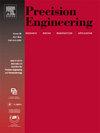提出了一种提高并联机器人运动参数辨识精度的新方法
IF 3.7
2区 工程技术
Q2 ENGINEERING, MANUFACTURING
Precision Engineering-Journal of the International Societies for Precision Engineering and Nanotechnology
Pub Date : 2025-04-11
DOI:10.1016/j.precisioneng.2025.04.007
引用次数: 0
摘要
并联机器人越来越多地应用于精密制造和测量领域。然而,装配误差和齿轮间隙等因素会导致末端执行器的定位误差达到几毫米,无法满足高精度加工和测量的精度要求。为了提高并联机器人的定位精度,参数标定已成为一种必不可少的技术手段。由于并联机器人系统在长期运行过程中,其精度可能会逐渐下降,因此对其运动参数的定期标定显得尤为重要。为了避免干扰测量系统的正常运行,迫切需要一种高效、高精度的机器人参数标定方法。本文提出了一种基于并联机器人运动误差模型的两步运动学参数辨识方法,保证了标定精度和显著的计算效率。第一步,采用L2正则化最小二乘(L2 RLS)方法对运动学参数进行预识别,得到次优参数值;随后,将次优值作为迭代法的初始值,迭代法通过迭代过程对参数辨识进行细化,得到最优参数值。数值仿真验证了该方法的有效性,在保证标定精度的同时显著提高了计算效率。实验结果进一步表明,采用本文提出的L2 RLS-IT方法,并联机器人的最大定位误差从1.872 mm减小到0.294 mm。这一显著的改进不仅证明了该方法的有效性,而且对保证高精度并联机器人的长期稳定运行起着至关重要的作用。本文章由计算机程序翻译,如有差异,请以英文原文为准。
A novel method for improving the accuracy of parallel robots based on efficient identification of kinematic parameters
Parallel robots are increasingly used in precision manufacturing and measurement applications. However, factors such as assembly errors and gear clearances can cause the positioning error of the end effector to reach several millimeters, which fails to meet the precision requirements for high-precision machining and measurement. To enhance the positioning accuracy of parallel robots, parameter calibration has become an essential technical approach. As the accuracy of parallel robot systems may gradually decline during long-term operation, regular calibration of the kinematic parameters is particularly important. An efficient and high-precision parameter calibration method for robots is urgently required to avoid disrupting the operation of the measurement system. This paper proposes a two-step method for identifying kinematic parameters based on the kinematic error model of parallel robots, ensuring both calibration accuracy and significant computational efficiency. In the first step, the L2 Regularized Least Squares (L2 RLS) method is used to pre-identify the kinematic parameters, obtaining suboptimal parameter values. Subsequently, the suboptimal values serve as the initial values for the iterative (IT) method, which refines the parameter identification through an iterative process to obtain the optimal parameter values. Numerical simulations have verified the effectiveness of the proposed method, ensuring calibration accuracy while significantly improving computational efficiency. Experimental results further demonstrate that applying the L2 RLS-IT method proposed in this paper reduces the maximum positioning error of the parallel robot from 1.872 mm to 0.294 mm. This significant improvement not only proves the effectiveness of the method, but also plays a crucial role in ensuring the long-term stable operation of parallel robots with high precision.
求助全文
通过发布文献求助,成功后即可免费获取论文全文。
去求助
来源期刊
CiteScore
7.40
自引率
5.60%
发文量
177
审稿时长
46 days
期刊介绍:
Precision Engineering - Journal of the International Societies for Precision Engineering and Nanotechnology is devoted to the multidisciplinary study and practice of high accuracy engineering, metrology, and manufacturing. The journal takes an integrated approach to all subjects related to research, design, manufacture, performance validation, and application of high precision machines, instruments, and components, including fundamental and applied research and development in manufacturing processes, fabrication technology, and advanced measurement science. The scope includes precision-engineered systems and supporting metrology over the full range of length scales, from atom-based nanotechnology and advanced lithographic technology to large-scale systems, including optical and radio telescopes and macrometrology.

 求助内容:
求助内容: 应助结果提醒方式:
应助结果提醒方式:


